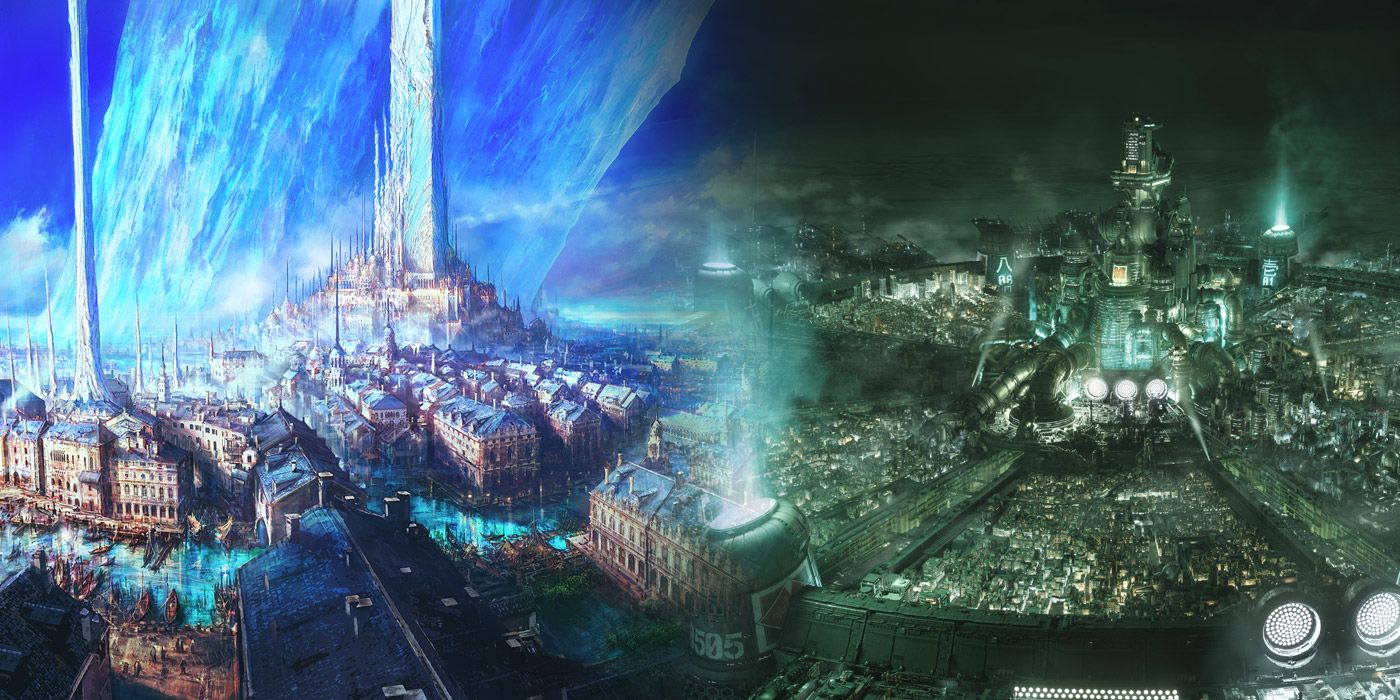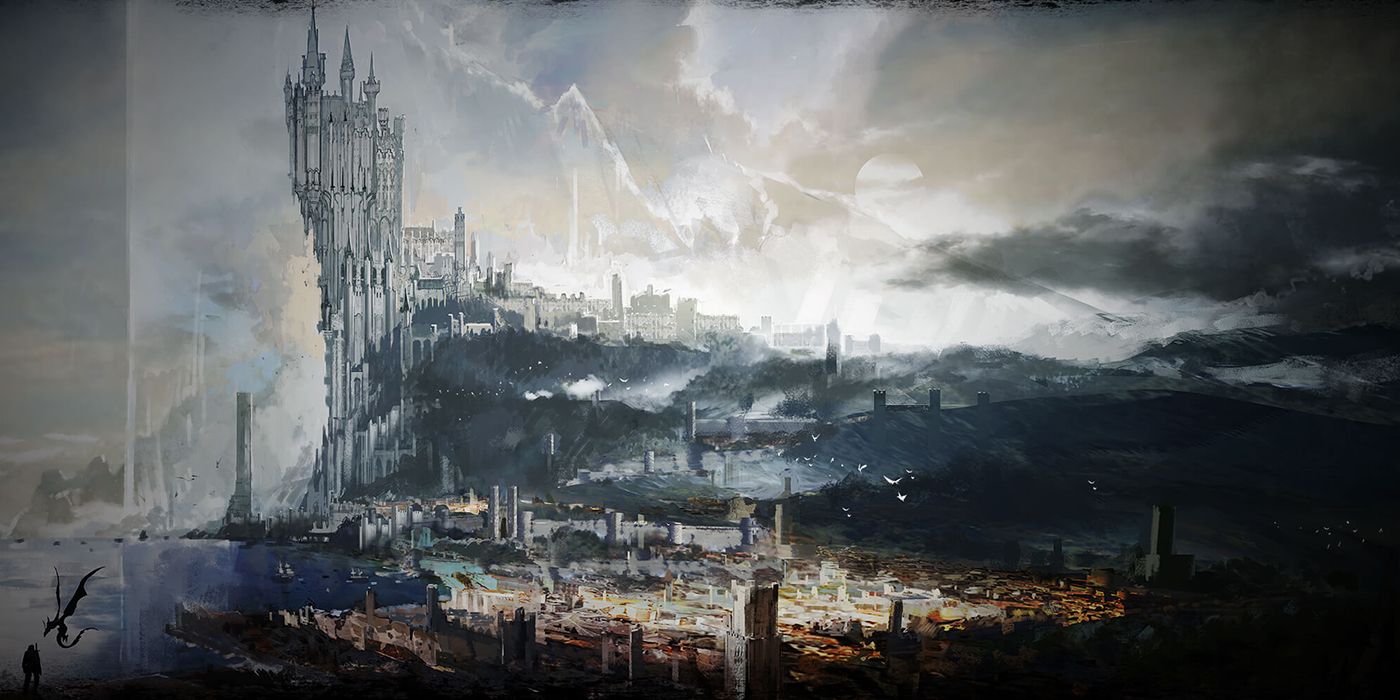At the PS5 showcase in September, Square Enix pulled back the curtain on Final Fantasy 16, showing off the magical, crystal studded world of Valisthea. The game's medieval nation states seem to be a sharp departure from Final Fantasy 7 Remake's retro-futuristic world of Gaia, whose aesthetic is dominated by the iconic mega-city of Midgar. But relatively little is known of Valisthea, and there is much more to Gaia than Midgar. In the end, the two worlds may have more in common than one would expect.
As a franchise, Final Fantasy is responsible some of the most memorable settings in JRPG history, particularly when the series blends genres between futuristic and fanciful, as per Midgar, Balamb Garden, and Zanarkand. While fanciful technology like airships have been a long-running staple of the series, Final Fantasy 6 ushered in a pronounced steampunk aesthetic, with imposing mechanized armor and magitek-fueled cities.
Valisthea seems to be aiming to a return to the series roots, however, similar to what Final Fantasy 9 did with the franchise. The kingdom of Alexandria had an almost Disneyland-ish quality to it, with clean, cobblestone-paved streets, blimp-like airships, and fairytale castle spires. Whereas there appears to be a grittier edge to Valisthea that is more reminiscent of modern fantasies like the settings from The Witcher and Game of Thrones.
Welcome to Scenic Valisthea
Square Enix has revealed a fair amount of information about Final Fantasy 16's world on the game's website, and the initial reveal trailer is studded with other telling Final Fantasy 16 details. Comprised of the east continent of Ash, and the west continent of Storm, the land is studded with towering crystals known as mothercrystals. These crystalline masses provide people with Aether, enabling the use of magic, and protect people from a disease simply referred to as the Blight. This effectively makes them the world's most valuable natural resource, and as one would expect, nation states have sprung up around them.
There are a total of six such kingdoms, referred to as "Realms," which suggests that Final Fantasy 16 will be taking pains to correct a major flaw from the Final Fantasy 13 trilogy and Final Fantasy 7 Remake—a reliance on linear pathways rather than open-world exploration, as per the franchise's long-running tradition. The realms include the Grand Duchy of Rosaria, the Holy Empire of Sanbreque, the Kingdom of Waloed, the Dhalmekian Republic, the Iron Kingdom, and the Crystalline Dominion.
In addition the mothercrystals, each of these realms has been blessed with a Dominant—human hosts for powerful spirits known as Eikons, which will be familiar to any Final Fantasy fan as the series' signature summoned creatures. And the land is also host to a number of classic enemies and creatures, including morbols, coeurls, and the ever-charming chocobo bird-steeds.
A Grimdark Fairytale
A great way to get a feel for Valisthea, apart from looking at the lore, is to study the Final Fantasy 16 characters' appearances and designs. The soldier characters eschew elaborate, buckle and zipper-laden attire for sensible leathers and metal armor, while the royalty dresses in courtly robes and other foppish attire that would not go amiss in most medieval period pieces. Even the most imposing foe, a dragoon-like enemy that the apparent protagonist faces in a courtyard, is sedate compared to the elaborately armored Judges of Final Fantasy 12 or the traditional, Yoshitaka Amano-inspired attire of Final Fantasy 14.
It is also worth noting that these characters get dirty. Faces are spattered with blood, ash, and grime mid-combat. City streets are muddy and patched with errant clumps of grass. While it may seem an innocuous detail, it goes a long way toward setting a mature tone for the Final Fantasy series. In fact, apart from the medieval aesthetic, it is the most pronounced departure from Final Fantasy 7 Remake's look, where, even amidst catastrophic explosions and hellish battles, the characters remain as clean as a K-pop idol group. This suggests that Valisthea is a grittier, more grounded world than Gaia. That is not to say the two worlds share no commonalities, however.
Greetings from Gaia
The greatest parallel in Final Fantasy 16 and Final Fantasy 7's world-building are the mothercrystals and mako reactors. Admittedly, wile mothercrytals are naturally occurring, and mako reactors are essentially examples of eco-terrorism taken to its most perverse extreme, both serve as the foundations for their respective civilizations. In each world, cities are built around sources of magical energy that allow their occupants to enjoy lives of ease and plenty. While Midgar boasts a staggering excess of mako reactors, remote regions like Nibelheim are also fueled by the planet-sucking engines. Details are forthcoming on Valisthea's blight illness, but both worlds seem to be defined by bastions of civilization dotting an expanse of wilderness teaming with monsters.
And while Midgar is the most iconic (and arguable most important) locale in Final Fantasy 7, it is important to remember that Gaia is a big world that we have seen precious little of so far. In the original Final Fantasy 7, the futuristic aspects of Gaia are not evenly distributed throughout the land. The nation of Wutai, which was long locked in a war with the evil Shinra Corporation bears a strong resemblance to Meiji-era Japan. Costa Del Sol and the Gold Saucer are both more modern, but resemble a central-American resort destination, and a quirky, mascot-saturated version of Las Vegas, respectively.
Grim Parallels
Both worlds appear to be reflections on the recent popular fiction that surround them, give or take a decade. Final Fantasy's city of Midgar has a distinctive, late 80s to late 90s feel, borrowing influences from cyberpunkish mega-cities, and crime-ridden metropolises from brooding action films. Valisthea, as noted earlier, seems to have more in common with Game of Thrones' bloody battlefields, or the squalid medieval city streets of King's Landing. Meanwhile, the muck and fog-saturated wilderness seen in Final Fantasy 16's trailer call to mind the locales Geralt frequents in The Witcher franchise.
But both worlds impart a strong sense of oppressive moodiness, however, if not outright grimness. The fanciful quality of early Final Fantasy titles, and Final Fantasy 9, are completely absent in what we have seen of Final Fantasy 16 so far. And while Final Fantasy 7 Remake certainly has a sense of humor, best exemplified by Cloud's cross-dressing stint, the game's themes of terrorism, economic disparity, and tragic backstories strike a melancholy chord.
Hopefully, Valisthea has its fair share of laughs, and Gaia has more sunny spots on the way. Fantasies without levity makes for dour journeys, indeed.
Final Fantasy 7 Remake is available now for PlayStation 4. Final Fantasy 16 is currently in development.


